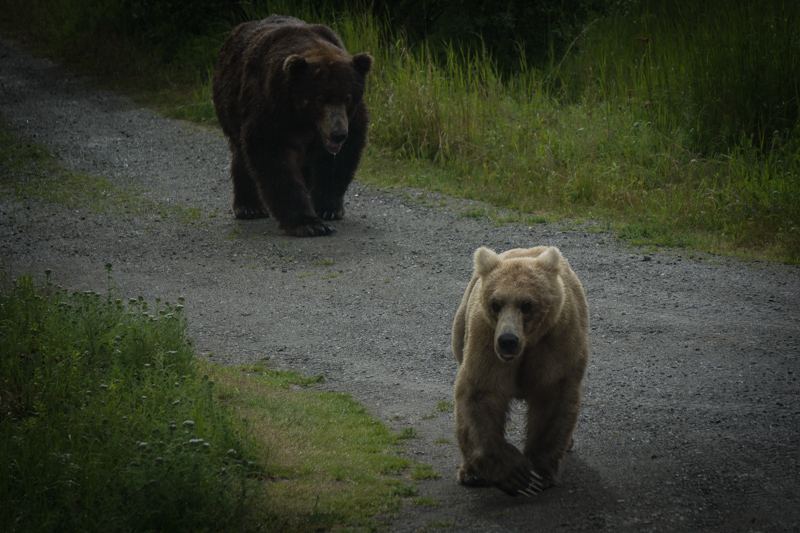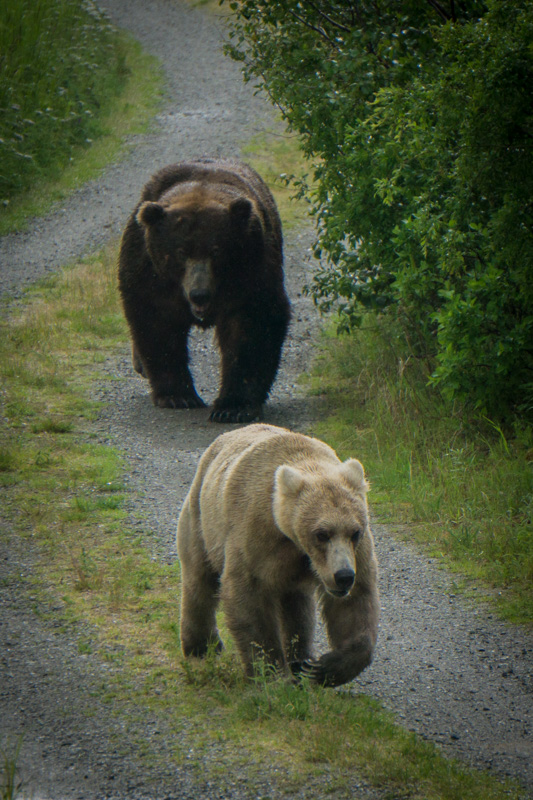
747 courts 435 Holly. NPS Photo/ A. Ramos.
Motherhood is especially challenging in bear world. Sows with cubs are always single moms, male bears play no role in child rearing. Mother bears are also almost always on the clock — a successful female can give birth to four or more litters of cubs throughout her lifetime, raising each for two and a half to three and a half years before emancipating her cubs. Then, the sow will spend as little as one precious summer on her own, finally able to focus solely on her own survival and putting on enough weight to make it through the harsh winter months.
435 “Holly” is one such sow who emancipated cubs at the beginning of the summer. By comparing 435’s impressive weight gain this year to previous summers when she had cubs, we can see how draining raising cubs can be.

435 Holly in late September of 2015 compared to mid August 2016. Photos courtesy of T. Carmack.
But female bears without cubs, like 435, aren’t gaining weight solely for their own welfare. These sows are preparing to give birth to yet another litter of cubs. For female bears, the struggle of procreation is never-ending.
“Holly” emancipated 503 and her biological cub in the first few weeks of June, roughly coinciding with the peak of the mating season for brown bears. The emancipation of cubs is likely less of a conscious choice and more of a biological necessity. As 435 went into estrous, male bears took notice and began to court her. This would be a very dangerous situation for cubs, as male bears sometimes prey on cubs and even other adult bears. To keep them safe, 435 drove her cubs away before large male bears began approaching her to mate.
 435 with her two cubs. NPS Photo/T. Carmack.
435 with her two cubs. NPS Photo/T. Carmack.
In mid June, 747 was seen courting “Holly,” and the two were later observed mating near the falls. Reports were also made of 435 being courted by 32 “Chunk.” Brown bears are serially monogamous,meaning they mate with several bears throughout the season, but will only be courted by one at a time. 435 may have mated with a number of other bears during the mating season. Next year, “Holly” may well give birth to another litter of cubs, and spend her next two years raising them.

747 courts 435 Holly. NPS Photo/A. Ramos.
This is the driving force behind 435’s massive weight gain this year. After mating, female bears go through a “delayed implantation.” If she does not put on enough weight, the fertilized egg in her uterus will abort. If she does put on enough weight (which she certainly appears to have,) the pregnancy will continue and she will give birth to newborn cubs in December or January. The process of delayed implantation allows female bears to utilize all of their calorie intake, regardless of whether they produce offspring or not.
435 “Holly” has proven herself to be a successful bear. She has seen her share of challenges in raising offspring, but this year was able to wean two cubs, sending them off into the world of sub adulthood.
This summer, 435 has been dialed in to a bear’s main concern: getting fat. We have seen her successfully fishing at the falls, generally near the downed log, and doing a whole lot of fruitful snorkeling on the lower river. As a result, “Holly” has put on some serious weight. Brown bears can steadily gain one to two pounds per day during the summer feasting season, and 435 seems to be pushing the upper end of that stat. Since the beginning of July, “Holly” may have gained 120 lbs. or more, and the season is not yet over.
As late summer melts into fall, leaves turn, weather changes, and bears like “Holly” will continue to get even fatter. Although they may appear to be taking a break from the challenges of raising cubs, they are still working hard to raise future offspring. Stay tuned to the bearcams next year at Explore.org to find out if 435 “Holly” will succeed in giving birth to a fourth litter of cubs.
